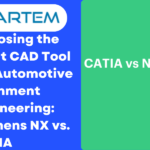Choosing the Right CAD Tool: A Graduate’s Guide to SolidWorks, Siemens NX, and CATIA
Congratulations, graduate! You’re on the tip of diving into the exciting world of Computer-Aided Design (CAD). As you embark on this journey, a critical decision awaits: which CAD tool should you learn to kickstart your career? In this blog, we’ll navigate through the industry landscapes of three prominent CAD tools — SolidWorks, Siemens NX, and CATIA — to help you make an informed choice tailored to your career aspirations.
- 1. SolidWorks: Bridging Simplicity and Power
Industry Recognition: SolidWorks has carved a niche for itself in industries ranging from product design to consumer goods. Its user-friendly interface and ease of learning make it a popular choice, especially for small to mid-sized enterprises.
Strengths for Graduates:
- User-Friendly: SolidWorks is known for its intuitive interface, making it an excellent starting point for beginners.
- Broad Applicability: Widely used in industries like consumer electronics, medical devices, and general manufacturing, SolidWorks provides versatility.
Consider SolidWorks if:
-
- You’re looking for an easy entry point into CAD.
- Your career trajectory is aligned with industries where SolidWorks is extensively used.
2. Siemens NX: Engineering Precision in Motion
Industry Recognition: Siemens NX dominates industries with high precision requirements, such as aerospace, automotive, and machinery. It’s the go-to choice for large enterprises and those pushing the boundaries of innovation.
Strengths for Graduates:
- Parametric Design Power: Siemens NX excels in parametric modeling, allowing for complex and precise designs.
- Comprehensive Simulation: Ideal for graduates interested in simulation-driven design processes.
Consider Siemens NX if:
-
- You’re aiming for a career in industries demanding high precision, like aerospace or automotive.
- Your interest lies in comprehensive simulation and engineering analysis.
3. CATIA: For the Architects of Complexity
Industry Recognition: CATIA is an industry leader, particularly in aerospace, automotive, and industrial design. It’s a robust choice for handling complex, surface-intensive designs.
Strengths for Graduates:
- Advanced Surface Modeling: CATIA’s surface modeling capabilities are unparalleled, making it a favorite for intricate designs.
- Collaborative Design: Ideal for graduates aspiring to work on projects with multiple collaborators.
Consider CATIA if:
-
- You’re fascinated by complex and aesthetically demanding designs.
- Your career goals align with industries prioritizing collaborative design environments.
Making Your Decision: Tailoring CAD to Your Career Path
- Evaluate Industry Demand: Research the industries prevalent in your region or those you aspire to work in. Identify which CAD tool is in high demand among potential employers.
- Consider Your Learning Style: Each CAD tool has its learning curve. Consider your learning preferences and explore introductory courses or trial versions to find a tool that aligns with your style.
- Long-Term Goals: Think about your long-term career goals. If precision engineering and simulation are your interests, Siemens NX might be a good fit. For versatile applications, SolidWorks could be ideal, while CATIA excels in intricate and collaborative design scenarios.
Conclusion: Your CAD Journey Begins
As you embark on your CAD journey, remember that the best tool for you is the one that aligns with your goals and aspirations. Whether it’s the versatility of SolidWorks, the precision of Siemens NX, or the complexity handling of CATIA, each CAD tool offers a unique set of strengths. So, buckle up, choose wisely, and enjoy the ride as you shape your future in the world of Computer-Aided Design!
| Aspect | SolidWorks | Siemens NX | CATIA |
|---|---|---|---|
| Industry Recognition | Widely used in product design, consumer goods, and small to mid-sized enterprises. | Dominant in industries requiring high precision like aerospace and automotive. | Industry leader in aerospace, automotive, and industrial design. |
| Strengths for Graduates | – User-friendly interface. | – Parametric modeling excellence. | – Advanced surface modeling capabilities. |
| – Versatility across industries. | – Comprehensive simulation tools. | – Ideal for intricate and collaborative design scenarios. | |
| Consider if… | – Ease of entry and broad applicability are essential. | – Precision engineering and simulation-driven design interest you. | – Complex, aesthetically demanding designs are your focus. |
| Long-Term Goals | – Versatile applications and broad industry scope. | – Precision engineering and simulation-driven design. | – Specialized in complex and collaborative design scenarios. |
Conclusion: Tailoring Your CAD Journey
As you venture into the realm of Computer-Aided Design, consider your career aspirations, preferred learning style, and the industries you aim to work in. Whether you choose SolidWorks, Siemens NX, or CATIA, each CAD tool offers a unique set of strengths. Your decision should align with your goals, ensuring a smooth and fulfilling journey as you shape the future of design and engineering.





